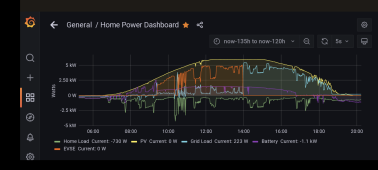Oh, maybe an easy idea to make the Emporia work. But also dumb, risky, and still a little complex.
I still prefer programming a Raspberry Pi or PLC.
But, you could take the emporia, put the grid current transformers on the DC batter cables. The emporia would crank up the charge current until the PV was going to the home loads and charger.
But, this still requires the SolArk to turn on the smart load, gen, whatever to power the EVSE after the battery is charged but before it has started curtailing PV production.
It also relies on Emporia going through simple route when the are figuring out the available EVSe current. You'd need it to work incrementally, where it turns on the EVSE to some minimum, looks at the "grid current" (in this case battery current) and decide if there is still enough excess current to make the next step up with the EVSE.
Also, it may require swapping out the type of current sensor for a different type. Plus you've got to hope the Emporia doesn't do a dumb because the current is DC, not AC.



